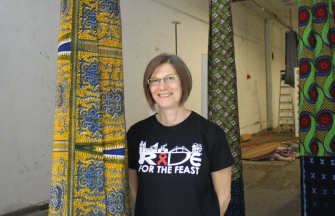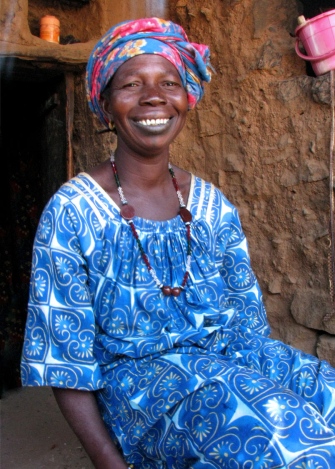Art
Water Sonettos
Collaborative exhibit emphasizes the importance of water
Published: May 9, 2012
As Jann Rosen-Queralt walks past a conical sculpture wrapped in brightly patterned African fabric, a voice emerges, triggered by motion detectors. “I am Dogon,” it says. “I was born Dogon into the Dogon family in Dogon land.” But you wouldn’t know that, because the words are in Bambara, a Dogon language. “We are born into this life,” the voice continues. “We can’t change our hard life, like a fish that is always in water.” Other voices—and ambient sounds of life in West Africa—chime in as Rosen-Queralt passes other sculptures in the In/Flux Gallery. The pieces, which were made by Rosen-Queralt, are part of Water Sonettos, an exhibition of women artists working around the theme of water.
Rosen-Queralt, a professor at the Maryland Institute College of Art, also organized the show, along with one of her former students, artist and curator C. Ryan Patterson. “For me it was less about limiting the show to women than [that] it just happened that these artists fit the criteria we created,” Patterson says, walking with Rosen-Queralt.
“Most of my work is not done locally,” Rosen-Queralt adds. “One of the things I’ve wanted to do is bring together this international perspective with a more local perspective, while bringing together the art, science, and nonprofit communities.”
Each of her sculptures is inspired by one of the Dogon women she met on a trip to Mali in 2011. The Osprey Foundation—a group that funds projects dealing with water, women’s issues, and poverty—funded her trip. She was there to observe the work of Lutheran World Relief (LWR), a nonprofit focused on sustainable development. LWR put Rosen-Queralt in touch with a co-op of about 70 women from 14 villages who were growing shallots. “They suffer annually from horrible droughts and in the most traditional Dogon culture, women have no say at all,” Rosen-Queralt says.
Rosen-Queralt met with the women to learn about their lives. She recorded their conversations and took photographs, but, she admits, felt wildly inadequate. “Here I am, an artist, and I think I’m going to help them,” she recalls thinking. But then she talked to a woman named Isa Kassogue. “She told me about being elected as the president of her village and how proud she was,” Rosen-Queralt says. “But she also expressed her nervousness, and I thought: Just like me.” This realization helped her see all the things she and these women had in common, despite the vast cultural and economic distances that separated them.
Photographs of the women hang on the wall alongside the sculptures, and in the center of the floor sits “Water Footprint,” a water-filled plastic bladder set in a porthole-like metal circle and covered with one cast-iron shallot for each of the women she met.
Water is a crucial issue in Mali, but Rosen-Queralt had been thinking about it since she took up scuba diving 15 years ago. Upon witnessing a submerged world, she began to think more about the role water plays in all of life. She began shooting underwater photographs and video, some of which are included in a series of three short films in the exhibition. “There’s a decorator crab who has decorated himself with all of this horrible amount of algae that shouldn’t be there,” she says pointing at one image. One of the films addresses the cyclical nature of water, from clouds to a rushing river to the crashing waves of the ocean. “I want the work to remain poetic, even though it is delivering a message,” Rosen-Queralt says. “The aesthetics matter. I’m hopeful that the work will be different than what you would find produced for the Chesapeake Bay Foundation, even if it has a similar goal.” There is a certain experimental flow to the films, but they read like a footnote to the sculptures and photographs. “I’m not a videographer any more than I am a photographer,” she says. “But they have become part of the methodology of my sculpture.”
Lisa Moren, a professor at the University of Maryland, Baltimore County and another artist featured in Water Sonettos, created marbleized paper using oil collected from the 2010 BP Deepwater Horizon oil spill in the Gulf of Mexico, as well as a series of watercolor postcards with pigments created from Chesapeake Bay mud and sediment.
The back gallery is what Patterson calls “a crazy laboratory of making it work.” Laure Drogoul’s playful work “Fauxbow” features a number of one-liter bottles filled with dyed water, nested together. The bottles are cut so that they can slide inside one another, with only the pressure of the water to hold them together. A light shining up through them projects a holograph-like rainbow on the wall. Though the work lacks the gravitas of some of the others, it is whimsical and surprisingly beautiful.
“Lost at Sea,” the work of a collective called Greenpants, is the only piece that seems out of place in the exhibition. It includes an animated projection of slogans moving across a building, part of a larger project in which the group plans to highlight west side development issues, especially the so-called Superblock. The piece feels disconnected from the rest of the show, the title providing the only tenuous connection.
Of the younger artists in the gallery, multidisciplinary artist Marian April Glebes most rigorously embraces the experimental aspirations of the show. Glebes curated a show called H2OMG at the D:center last year and has been working on a project called Emergency Survival Tactics since 2008. She began the project in Ohio, where she and other community members believed that the tap water was making them sick. Waterborne microbes were never confirmed, but the incident got Glebes thinking about transparency, trust, and water. She began to investigate a variety of filtration systems, asking people in public places to trust her by taking sips of water she offered them. The documentation of this ongoing public art project gives the back of the gallery the feel of a laboratory. “The experimental process was the same as the artistic,” Glebes says.
In an attempt to push this kind of cross-disciplinary thinking, Patterson and Rosen-Queralt have scheduled a series of educational projects in the back of the gallery, where they have also set up a resource room, because, in the end, the show is more about the ways people interact with water than it is about the substance itself. “I’m hoping people might not only think about it, but also change their behaviors,” Rosen-Queralt says. As if to amplify this point, Eileen Wold has filled part of the gallery floor with trash collected from the shores of Baltimore’s harbor. More exhortation than exploration, Wold’s work drives home the local importance of Water Sonettos.
> Email Baynard Woods
To comment you must first create a profile and sign-in with a verified DISQUS account or social network ID. Sign up here.
Comments in violation of the rules will be denied, and repeat violators will be banned. Please help police the community by flagging offensive comments for our moderators to review. By posting a comment, you agree to our full terms and conditions. Click here to read terms and conditions.
















Glad you liked it. Would you like to share?
Showing 0 comments
Add New Comment
Reactions